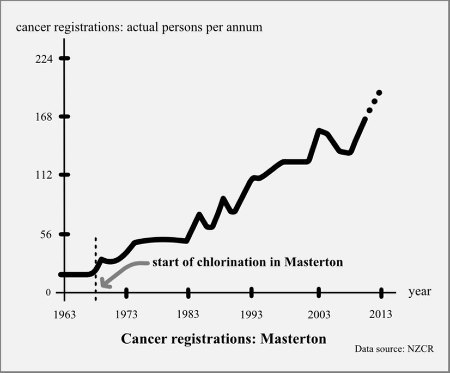
Masterton water supply upgrade
Stephen G Butcher (B.Arch, Dip.BS)
Page first published 13/07/11
Most recent update 13/10/17

Welcome to cancer.net.nz and my information page for Masterton.
There are two issues of which you may not be aware but which significantly affect your health and wellbeing.
The first is the addition of hypochlorous acid to Masterton's water supply and the second is the dosing of the water supply with fluorosilicic acid.
Hypochlorous acid:
As you can see from the graph, cancers in Masterton have gone absolutely ballistic since the late 1960s (data supplied by NZ Cancer Registry). Cancer has gone from a rare disease to one which is almost unavoidable and this is due to the addition of hypochlorous acid to Masterton's water supply.
Hypochlorous acid is a well known cancer causing "reactive oxygen species" or "ROS." This ROS is usually formed, along with other ROS, as a result of exposure to radio activity, e.g. X-rays. But in Masterton it is added, via chlorination, to our drinking water to kill bacteria. The side effects of this stupid practice are discounted as being less important than the primary purpose of disinfection.
There is no end in sight. The previous Mayor, Garry Daniell, stalled any improvements during his term in office and the current Mayor, Lyn Patterson, has confirmed her intention to maintain the status quo.
Masterton's cancer epidemic is of a class of cancers called carcinomas. These are cancers of the epithelial tissues. They are mainly cancers of the lung, bladder, rectum, kidney, stomach, liver, pancreas, intestinal tract, breast and uterus. They are directly the result of using hypochlorous acid ROS in the water treatment plant at Kaituna.
Since the late 1960s the cancer epidemic in Masterton has been affecting people of increasingly younger age. When hypochlorous acid dosing started, mainly the elderly were affected. But as people are now exposed to this acid from birth, the age of cancer sufferers has moved forward: rather than people developing cancer in their 70s, it is now affecting people in their 50s.
In the USA, their Environmental Protection Agency (EPA) recognises the connection between ROS and cancer - and recommend that the practice of using ROS be replaced by filtration to 1 micron. This is called the "LT2 Rule."
The Masterton District Council has declined to adopt LT2.
The following links are a very small sample of submissions which I have made to MDC since early 2011 but which give enough clues to the problems in Masterton:
Nov 2012: Report showing ages of those getting carcinomas
Feb 2013: $650,000 estimate for new LT2 filters
May 2013: $474,555 quotation for three new sand filters
(including papers on the costs of preventable cancers in Masterton)
May 2013: $357,500 base quotation for new LT2 filters
July 2013: $214,730 additional costs for new sand filters (p.303)
The LT2 Rule is best implemented in two ways. First, a clean and secure water source is required. Secondly, installation of filtration to 1 micron at the point of use. This satisfies the "two barrier principle" which requires the control of infection at source and the control of infection which may be introduced into the reticulation system (the debacle in Havelock North was due to infection at source and the absence of a second barrier).
This would be cheaper than the current system. It would also control cysts, such as giardia and cryptosporidium, which the present system cannot.
Fluorosilicic acid:
This acid is removed from fertilizer because it creates a failure to thrive condition in livestock. For some reason it is wrongly assumed that the same does not happen to our children.
Research by Kick et al in the 1930s (still valid today) shows in detail the effects on bones, teeth, kidneys and so on. Similar research by Kick et al (1935) shows how this fluoride salt, unlike naturally occurring fluoride, is a cumulative poison - it is not excreted in proportion to intake.
The District Council adds this cheap-as-chips chemical to Masterton's water supply on the incorrect presumption that it behaves like naturally occurring fluoride and without regard to the ill effects on residents' health and wellbeing.
The Kick articles can be found here:
Kick et al 1933
Kick et al 1935
Like hypochlorous acid, this chemical is highly dangerous and there are much safer and more effective alternatives. The Childsmile programme, for example, encourages tooth brushing in schools and has proved to be highly successful in Scotland (well, it is scottish so it has to be good!).
Thank you for visiting my page.
